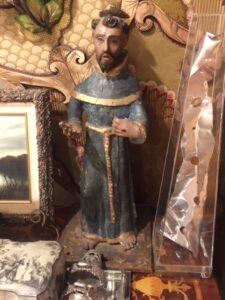 I want to tell you a personal story of an object my partner gifted me this holiday season. This Santos figure of Saint Francis stands thirty-two inches tall. Although I own a few Spanish Colonial Santos, I consider this one unique. His finely wrought glass eyes follow me, and his mournful expression moves me.
I want to tell you a personal story of an object my partner gifted me this holiday season. This Santos figure of Saint Francis stands thirty-two inches tall. Although I own a few Spanish Colonial Santos, I consider this one unique. His finely wrought glass eyes follow me, and his mournful expression moves me.
My interest in works of art called Santos lies in the mix of cultures and craft traditions they represent in the 18th and 19th centuries. Saint effigies have been “in production” for hundreds of years. When the tradition of sculpting lifelike figures of the Saints came to the Americas, a unique art form began based on archetypes from Flanders, Spain, and Italy. In areas with a heavy Spanish presence artisans who worked in an ancient style of carving based on local woods, and decorated with local pigments, adapted that form.
Repaired Santos Tell of Changing Traditions
Since many Santos underwent repairs (more about that later) over the years, the repairs themselves tell a story of changing traditions wrought by many hands. In the case of a Santos, a repair or overpaint shows a sign of authenticity and—devotion.
Before certain Holy Days, or during times of trouble, the faithful “cleaned” and dress these figures. In the case of my Saint Francis, somebody repaired, not very professionally, the back of his cowl, then overpainted it with flesh colored house paint. Not unexpected. I also see signs of cleaning, a bit too rigorously, and traces of overpainting.
Due to his large scale a church likely used my St Francis for public devotion, set into a altar, for example. My partner also gave me a Saint John holding a book Santos. Because of its small scale people probably used it in a home altar. Somebody also repaired Saint John, and overpainted his robe with fake gold paint.
Paint Colors on Santos Gives Clues
This palette of many colors is called “polychrome,” a tradition which flowed from Europe as a method of painting carved and gessoed wood. The base usually comes in soft grained wood, overlaid with animal glue, and a coating of chalk, both needed for the paint surface. The the richness of colors used further reinforces that my large Saint Francis was used for public devotion. He shows areas of gold leaf, supported underneath by clay and glue, his tunic decorated with incised cross hatching, imitating the texture of the fabric.
Artisans typically used oil paints, but we also find tempera (paints in egg yolk). Saint Francis represents the wisdom of poverty, hence his dull colored brown/green vestment. Gold leaf indicates the richness of his sainthood and “message.” The use of the expensive blue color, as well as gold leaf, gives us a clue. Brown or green came cheaper, which shows the reality of poverty and holiness in one Santos.
Unlike two-dimensional artwork of the same period, a “refresh” of the paint surface indicated veneration of the Saint. Artisans usually used local woods. For the more public Santos they purchased imported woods at a great price when it arrived in ships from Cuba or Honduras. Conservators of such works make difficult decision about restoration. Layers of paint do indicate care and love, and the idea of bringing a work back to the ‘original’ condition becomes questionable. They also discourage cleaning with modern restoration solvents, as the various layers of paint react differently to these. Alcohol based solvents eat away at certain paints. I consider the most conservative approach the best. Keep the Santos out of changes of temperature and humidity because wood expands and contracts in those cases.
Where was my Saint Francis created?
The lifelike soulful expression on the face, humanlike glass eyes, and the quality of the face molding, I peg the work as Peruvian, late 18th century. The artisan didn’t achieve the expression on the face in wood alone. He used a mixture of wax, rosin, and chalk to mold the fine dignified expression. The meticulously crafted glass eyes indicate a Peruvian origin, as these enriched the deeply expressive, mannerist style. The artisan aimed to create a Santos that imitated life. The eyes are so realistic the devotee thinks they see. And perhaps they do.